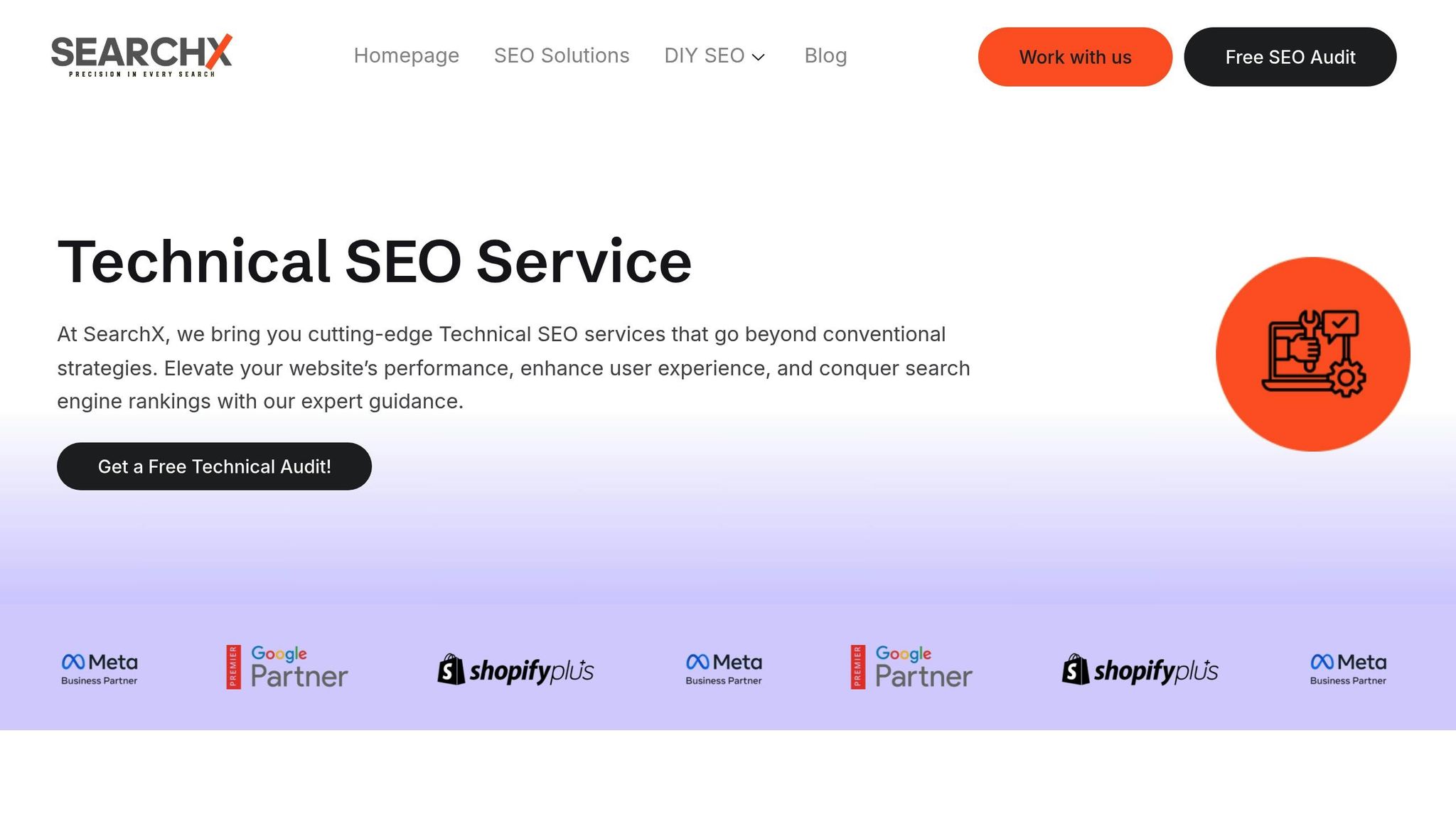Crawlability directly impacts whether your e-commerce products are visible in search results. If search engines can’t properly crawl your site, your pages might not get indexed, resulting in lost traffic and sales. Common problems include blocked pages, duplicate URLs, and broken links. Here’s how to fix them:
- Check robots.txt: Ensure important pages are accessible and CSS/JavaScript files aren’t blocked.
- Manage URL parameters: Use canonical tags to avoid duplicate content and save crawl budget.
- Fix noindex tags: Remove them from key pages like categories and products.
- Repair internal links: Address broken links, orphaned pages, and redirect chains.
- Handle duplicate content: Consolidate product variations with canonical tags and unique descriptions.
Use tools like Google Search Console or Screaming Frog to identify and resolve these issues. Regular audits, updated sitemaps, and monitoring crawl stats will help maintain a crawlable, search-friendly site.
I tried 50 Technical SEO Strategies, Here’s What’s Working RIGHT NOW In 2024 (eCommerce SEO Guide)
Common Crawlability Problems in E-commerce Sites
E-commerce websites often encounter technical issues that can hinder search engines from effectively crawling and indexing their content. These challenges typically arise from the complexity of online stores, which may have thousands of pages, dynamic filters, and fluctuating inventory. Identifying these problems is the first step to resolving them.
Blocked URLs in robots.txt
The robots.txt file acts as a guide for search engine crawlers, indicating which pages they can or cannot access. Unfortunately, many e-commerce sites unintentionally block crucial pages that should be accessible.
A few common missteps include blocking entire product categories, seasonal collections, or sale pages. Some websites restrict their /search/ directory entirely, which prevents crawlers from finding products via internal search results. While blocking /admin/ is appropriate, mistakes occur when /product-admin/ – containing valid product details – is also blocked.
Another major issue is blocking CSS and JavaScript files. Although these aren’t product pages, search engines rely on them to render and understand how pages appear to users. If these resources are inaccessible, Google can’t accurately interpret your site, potentially harming your rankings. Allowing access to these files not only improves crawlability but also boosts overall SEO.
Too Many URL Parameters
E-commerce websites often generate numerous URL variations through filtering, sorting, and tracking parameters. For instance, a single product category may produce hundreds of URLs like /shoes?color=red&size=9&sort=price.
This leads to two key problems. First, it exhausts your crawl budget – the limited time and resources search engines allocate to crawling your site. Instead of indexing new products, crawlers get bogged down processing endless filtered versions of the same page.
Second, URLs with excessive parameters often result in duplicate content. For example, a page for "red shoes sorted by price" might be nearly identical to one for "red shoes sorted by popularity." Search engines struggle to identify the most relevant version to index, which can dilute the ranking strength of your important category pages.
Noindex Tags on Important Pages
Noindex tags instruct search engines to exclude specific pages from search results. While these tags are useful for checkout pages or user account areas, they sometimes end up on pages that should remain indexed.
This issue frequently arises during website migrations or redesigns, where noindex tags are added to staging environments but not removed when the site goes live. Another common scenario involves out-of-stock products – some sites automatically apply noindex tags to these pages and fail to remove them once inventory is replenished.
Category pages are particularly at risk. Noindex tags intended for filtered pages can mistakenly target main category pages, making entire product lines disappear from search results.
Broken Internal Links and Navigation Problems
Broken internal links create dead ends that disrupt both user experience and search engine crawling. In e-commerce, these issues can escalate quickly due to frequent product updates and inventory changes.
The most obvious problem is 404 errors, caused by links to discontinued products or relocated categories. However, subtler issues like orphaned pages – pages with no internal links pointing to them – can also arise. These are often seasonal products removed from navigation but still stored in your system, leaving them undiscoverable by crawlers.
Redirect chains further complicate navigation. For example, if a product URL redirects to a category page, which then redirects to another category, and so on, it creates unnecessary friction. Each redirect consumes crawl budget and may prevent crawlers from reaching the final destination.
Duplicate Content from Product Variations
Product variations present another crawlability challenge. A single item, like a t-shirt, might have different URLs for each color, size, or style, leading to nearly identical content across multiple pages.
Faceted navigation only amplifies this issue. When users filter products by attributes like brand, price, or size, it generates unique URLs for each combination. For instance, "Nike running shoes under $100 in size 10" might share 80% of its content with "Nike athletic shoes under $100 in size 10."
The problem isn’t just the duplication itself. Search engines waste time crawling multiple versions of the same content instead of focusing on indexing your most important and distinct pages.
How to Fix Crawlability Problems
Here’s how you can resolve crawlability issues and make your site more accessible to search engines.
Fix Your robots.txt File
Your robots.txt file plays a critical role in guiding search engines. If it’s not set up correctly, it might block important content or allow access to areas that shouldn’t be crawled. To check your file, visit yoursite.com/robots.txt.
- Unblock important directories: Ensure that directories like
/products/,/categories/, or/collections/are accessible to crawlers. - Restrict sensitive areas: Keep directories like
/admin/,/checkout/, and/account/blocked to protect private or irrelevant pages. - Allow CSS and JavaScript files: Search engines need these resources to render and understand your pages. If they’re currently blocked, update your file with directives like:
Allow: /css/ Allow: /js/ Allow: *.css Allow: *.js
For more detailed guidance, platforms like SearchX offer in-depth advice on optimizing your robots.txt file, especially for e-commerce sites. Once this is sorted, the next step is managing URL parameters.
Control URL Parameters
URL parameters can create duplicate URLs that confuse search engines, but you can address this issue with a few strategies:
- Use canonical tags: For instance, if a product page has variations like
/shoes/nike-air-max?color=red&size=9, set the canonical tag to point to the base URL,/shoes/nike-air-max. This helps consolidate ranking signals and eliminates duplicate content concerns. - Optimize category pages: If your category pages have filters, use canonical tags to point filtered pages back to the main category (e.g.,
/shoes/). - Disallow unnecessary parameters: Update your robots.txt file to block URLs with session IDs, tracking codes, or other non-essential parameters, such as:
Disallow: /*?sessionid=
With URL parameters under control, it’s important to review meta directives on key pages.
Remove Noindex Tags from Key Pages
Meta robots tags can inadvertently block important pages from being indexed. Use a crawling tool to find all pages with noindex tags and review them carefully.
- Product pages: Some platforms add noindex tags to out-of-stock items. Make sure these tags are removed when products are back in stock.
- Category pages: These pages are crucial for navigation and SEO. If noindex tags are present on main category or collection pages, remove them immediately.
- Filtered pages: While extremely specific filtered pages might warrant noindex tags, broader filters that add value should remain indexed.
- Staging environment tags: If noindex tags were used during testing, ensure they’re removed before going live. Automated tools can help flag these tags in production environments.
Once your meta directives are in check, turn your attention to your internal linking structure.
Fix Broken Internal Links
Broken links disrupt crawl paths and waste crawl budget. Conduct a full site crawl to identify and fix internal link issues.
- Resolve 404 errors: Update or redirect broken links. For discontinued products, redirect users to a relevant category or similar product instead of the homepage.
- Address orphaned pages: Compare your sitemap to crawl results to find pages without internal links. Add links to these pages or remove them if they’re unnecessary.
- Eliminate redirect chains: Instead of chaining multiple redirects, link directly to the final destination to save crawl budget and improve navigation.
- Enhance linking between related pages: Add contextual links between products and categories to improve crawler access and distribute page authority more effectively.
Finally, tackle duplicate content issues to ensure your site remains streamlined.
Handle Duplicate Content
Duplicate content can dilute your site’s SEO efforts, but it’s manageable with the right approach:
- Canonical tags: Consolidate duplicate content by setting canonical tags on product variations. For example, if a product comes in multiple colors, use the base product URL as the canonical.
- Faceted navigation: Use canonical tags to point filtered pages back to their parent categories, reducing the number of indexed combinations while maintaining user functionality.
- Unique product descriptions: Avoid using manufacturer-provided descriptions. Write custom descriptions that highlight the unique features, benefits, or use cases of each product.
- Consolidate product variants: Instead of creating separate pages for each variation, combine them into a single page with selection options (e.g., color or size).
- Seasonal content: For temporary sale pages, use canonical tags to link back to the main product or category pages. This way, ranking signals are concentrated on evergreen content instead of being split across temporary URLs.
Tools for Crawlability Analysis
Once you’ve tackled crawlability challenges, it’s time to dive deeper with tools designed to assess and monitor your site’s performance. These tools streamline what could otherwise take weeks of manual checks, delivering actionable insights in just hours. Here’s a breakdown of some of the most effective crawlability tools for U.S.-based e-commerce businesses.
Top Tools for Crawlability Testing
Google Search Console is a must-have for understanding how Google interacts with your site. It’s free and provides real-time data about your site’s crawl status. The Coverage report highlights which pages Google can or can’t access, while the URL Inspection tool lets you analyze individual pages instantly. E-commerce businesses should focus on the crawl stats section, which details the number of pages Google crawls daily and flags any errors.
Screaming Frog SEO Spider is ideal for comprehensive crawls, especially for large e-commerce catalogs. The free version covers up to 500 URLs, while the paid version ($259/year) allows unlimited crawls. It identifies broken links, duplicate content, and missing meta tags across your site. Its custom extraction feature is particularly handy for analyzing product data and pricing.
SearchX’s technical SEO services cater specifically to e-commerce needs. Their technical SEO audits go beyond standard crawl reports, addressing issues like product page accessibility, category navigation, and checkout flow crawlability.
| Tool | Best For | Pricing | Key Strengths | Limitations |
|---|---|---|---|---|
| Google Search Console | Real crawl data from Google | Free | Direct insights from Google, real-time data | Limited historical data, Google-specific focus |
| Screaming Frog | Comprehensive site audits | Free (500 URLs), $259/year | Detailed analysis, bulk data export | Steeper learning curve, resource-heavy |
| SearchX Technical SEO | E-commerce-specific analysis | Custom pricing | Tailored expertise, actionable recommendations | Requires investment, not DIY |
Sitebulb is another standout tool, offering visual crawl maps that clearly show your site’s structure. This feature is especially helpful for e-commerce sites with complex category hierarchies. At $35/month, it delivers insights into internal linking and crawl efficiency that are hard to find elsewhere.
DeepCrawl (now part of Lumar) is built for enterprise-level analysis. For large e-commerce operations with thousands of products, its scheduled crawls and change detection features are huge time-savers. Starting at $89/month, it’s best suited for established businesses with larger budgets.
These tools provide a solid starting point for analyzing crawlability. But before committing to paid solutions, consider the free resources offered by SearchX.
Free Tools from SearchX

SearchX has developed several free tools to help businesses identify crawlability issues without upfront costs. Their Free Website Audit Tool delivers an instant technical analysis of your site, pinpointing major crawlability problems that might block search engines from accessing your products and category pages.
This tool checks for common e-commerce issues, such as blocked CSS and JavaScript files, errors in robots.txt directives, and problematic URL structures. It also provides a prioritized list of issues with recommendations, helping you tackle the most critical problems first.
For businesses with physical locations or local delivery services, the Free GMB Audit Tool is a perfect complement. It ensures your local business information is properly structured and accessible to search engines. This tool identifies schema markup issues and local SEO problems, which can indirectly affect crawlability.
SearchX’s free tools focus on providing actionable next steps, such as updating your robots.txt file, fixing broken links, and addressing duplicate content issues. They also explain why these fixes are crucial for e-commerce sites, helping you prioritize tasks that could directly impact revenue.
For smaller e-commerce businesses, these free tools are an excellent starting point. They allow you to address key issues and improve crawlability before investing in more advanced, paid solutions.
How to Prevent Future Crawlability Problems
After resolving existing crawlability issues, the next step is to ensure your site stays in top shape. Regular upkeep becomes especially important for e-commerce sites, where product catalogs and seasonal campaigns change frequently. By taking proactive steps, you can avoid repeated problems and protect both your site’s performance and your revenue.
Run Regular Technical SEO Audits
Set up a monthly routine to audit key aspects of your site, such as product pages, category structures, and checkout processes.
SearchX’s technical SEO services provide in-depth audits tailored specifically for e-commerce sites. These audits go beyond basic checks, analyzing how updates like product variations, inventory changes, and promotional campaigns impact crawlability. This level of detail can uncover issues that generic tools might overlook.
During these audits, focus on identifying broken links caused by product updates, ensuring seasonal category pages remain accessible, and verifying that promotional landing pages are not unintentionally blocking search engines. For larger sites, consider increasing audit frequency during peak shopping periods or major sales events.
Keep a detailed record of audit findings and track recurring problems. If certain errors repeatedly show up in specific sections of your site, it’s a clear signal to focus your efforts there. Addressing these patterns early can prevent them from escalating.
Monitor Crawl Stats and Errors
Audits are just the start – ongoing monitoring is essential to catch issues as they arise. Google Search Console is an excellent tool for this, offering reliable data on how Google crawls your site. The Crawl Stats report is particularly helpful for sites with over 1,000 pages.
Check the Host Status weekly. A red status indicates critical issues like problems with robots.txt fetching, DNS resolution, or server connectivity – any of which can halt Googlebot’s crawling. For example, if Google can’t fetch your robots.txt file for 12 hours, crawling stops. If the file stays unavailable for 30 days, Google will ignore it entirely and crawl without restrictions.
Pay close attention to crawl responses. Most should return a 200 (OK) status. A spike in 404 errors might mean broken internal links, while 5xx errors suggest server issues that need immediate action. Drops in crawl activity or sudden spikes in errors could indicate site instability, which might lead search engines to deprioritize your site.
"Just because you can access a page in your browser doesn’t mean Googlebot can." – Martin Splitt, Google Search Central.
Enable email alerts in Google Search Console under Preferences to stay informed about critical issues like pages being dropped from the index, coverage problems, or security concerns. Acting quickly on these alerts can prevent minor issues from snowballing.
The URL Inspection Tool is another valuable resource. Use it to check specific pages when problems arise. It shows exactly what Googlebot sees, including any blocks caused by robots.txt or meta directives. Regularly testing your most important product and category pages ensures they remain accessible.
Since Googlebot switched to Mobile Googlebot as the default user agent on July 5, 2024, mobile optimization has become a key factor in crawlability. Monitor mobile crawl stats separately to catch any mobile-specific issues that could affect how Google views your site.
Keep Your Sitemaps Updated
An outdated sitemap can waste Google’s crawl budget and slow down the indexing of new products. For e-commerce sites, dynamic sitemap management is essential to keep up with inventory changes.
Automate sitemap generation to avoid human errors. Many platforms like Shopify, WooCommerce, and Magento offer built-in tools or plugins to regenerate sitemaps automatically when products are added, categories are updated, or URLs are changed.
Make sure your sitemaps only include active, crawlable pages. Remove URLs for discontinued products promptly – listing out-of-stock or deleted products not only wastes crawl budget but can also result in 404 errors.
Break large sitemaps into smaller, more focused files. For example, create separate sitemaps for products, categories, blog posts, and static pages. This organization helps Google better understand your site structure and prioritize important content. Product sitemaps should be updated most frequently, while static page sitemaps may only need monthly reviews.
Submit updated sitemaps through Google Search Console to speed up the indexing of new content. Regularly check for sitemap errors, such as blocked URLs, server issues, or redirect chains, and resolve them as needed.
Sitemap maintenance becomes even more critical during seasonal promotions or major site updates. If you’re rolling out significant changes to your product catalog or site architecture, make sure to include sitemap updates in your planning. This ensures search engines can efficiently crawl and index your new content.
Conclusion
Crawlability issues can significantly hinder your e-commerce site’s performance, making it harder for search engines to find your products and costing you valuable organic traffic. It’s the foundation of SEO – without it, even the most well-crafted product pages won’t appear in search results. For e-commerce businesses, this translates into missed sales and higher costs to acquire customers. Addressing these challenges is key to achieving long-term SEO success.
The technical fixes we’ve covered – like optimizing robots.txt files, managing URL parameters, addressing duplicate content, and strengthening internal linking – lay the groundwork for better search engine indexing. This is especially critical as 60% of online shopping queries now come from mobile devices. Ensuring mobile-first crawlability is no longer optional; it’s a necessity for staying competitive.
Consistency is crucial. E-commerce sites are dynamic, with frequent updates such as new products, seasonal promotions, and inventory changes. Regularly using tools like Google Search Console, keeping XML sitemaps up to date, and conducting monthly technical audits can help maintain the improvements you’ve made and ensure your site remains optimized for search engines.
For ongoing support, expert technical SEO services can make a big difference. SearchX’s technical SEO services offer tailored solutions for e-commerce challenges, from analyzing the impact of product variations and inventory updates to ensuring search engines can easily access your site. Whether you have a complex product catalog or just need consistent monitoring, professional assistance can help you stay focused on growing your business while keeping your site in top shape.
As you tackle crawlability issues, prioritize resolving blocked pages in robots.txt, fixing broken links, and eliminating duplicate product content. These steps often yield the most noticeable improvements in search engine visibility. With these fixes in place, you’ll set the stage for better indexing, increased organic traffic, and ultimately, more sales for your e-commerce site.
FAQs
How can I optimize my e-commerce site’s robots.txt file to improve crawlability while protecting sensitive areas?
To fine-tune your e-commerce site’s robots.txt file, make sure to block access to directories that hold sensitive information, like admin dashboards, user data, or payment-related details. It’s a good idea to routinely check and update this file to prevent unintentionally exposing private paths.
Don’t include sensitive URLs directly in the robots.txt file – doing so could make them a target for misuse. Instead, prioritize secure site architecture and implement proper access controls to protect restricted areas. A well-organized and thoughtfully maintained robots.txt file not only helps search engines navigate your site more effectively but also ensures your critical data stays protected.
How can I manage URL parameters in e-commerce to prevent duplicate content and improve crawl efficiency?
Managing URL Parameters for E-Commerce SEO
When it comes to managing URL parameters in e-commerce, it’s all about ensuring that search engines focus on the right pages. Parameters like filter options, sorting preferences, and tracking codes can create a maze of duplicate or unnecessary URLs that waste your crawl budget.
To handle this effectively, you can use Google Search Console to guide search engines on how to treat your parameters. Another option is updating your robots.txt file to block crawling of parameterized URLs that don’t add value. This keeps search engines focused on the pages that matter most.
Additionally, implementing canonical tags is a smart way to indicate the preferred version of a page. This helps consolidate ranking signals and avoids duplication issues, ensuring your site is easier for both users and search engines to navigate. These strategies not only improve crawl efficiency but also give your SEO efforts a boost.
How can I monitor and avoid crawlability issues on my e-commerce site, especially during busy shopping seasons?
Staying Ahead of Crawlability Issues During Peak Shopping Seasons
High-traffic shopping seasons can put a strain on your website, making it crucial to stay on top of technical issues that could impact performance. Regular technical audits are your first line of defense. These audits can help you catch potential problems like broken links, duplicate content, or pages that load too slowly – issues that can frustrate users and hinder search engine crawlers.
To tackle these challenges, make use of tools that provide real-time monitoring. These tools allow you to quickly spot crawl errors or performance bottlenecks, especially during traffic surges, so you can address them before they affect your site’s usability or rankings.
It’s also important to focus on optimizing server response times and implementing effective caching strategies. Additionally, check that any third-party scripts or elements on your site aren’t creating roadblocks for search engine crawlers. By taking these proactive steps, you can ensure a seamless shopping experience for both your customers and search engines, even during the busiest times.




